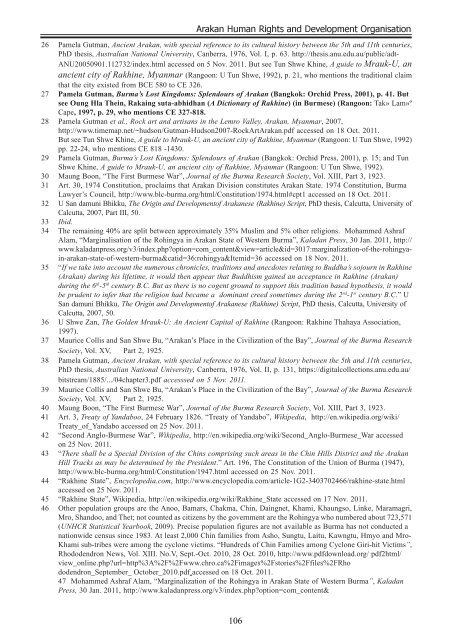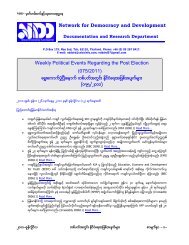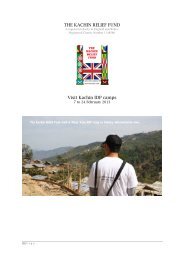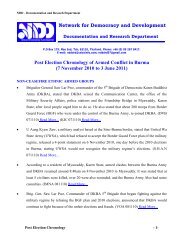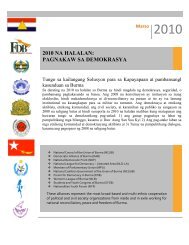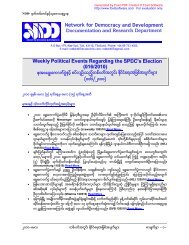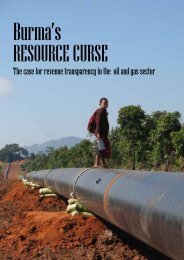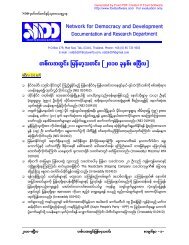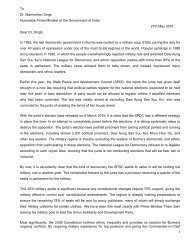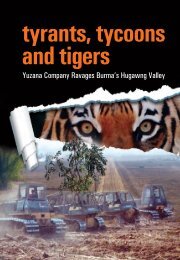Cyclone Giri - Two Years On - Burma Action Ireland
Cyclone Giri - Two Years On - Burma Action Ireland
Cyclone Giri - Two Years On - Burma Action Ireland
You also want an ePaper? Increase the reach of your titles
YUMPU automatically turns print PDFs into web optimized ePapers that Google loves.
Arakan Human Rights and Development Organisation<br />
26 Pamela Gutman, Ancient Arakan, with special reference to its cultural history between the 5th and 11th centuries,<br />
PhD thesis, Australian National University, Canberra, 1976, Vol. I, p. 63. http://thesis.anu.edu.au/public/adt-<br />
ANU20050901.112732/index.html accessed on 5 Nov. 2011. But see Tun Shwe Khine, A guide to Mrauk-U, an<br />
ancient city of Rakhine, Myanmar (Rangoon: U Tun Shwe, 1992), p. 21, who mentions the traditional claim<br />
that the city existed from BCE 580 to CE 326.<br />
27 Pamela Gutman, <strong>Burma</strong>’s Lost Kingdoms: Splendours of Arakan (Bangkok: Orchid Press, 2001), p. 41. But<br />
see Oung Hla Thein, Rakaing suta-abhidhan (A Dictionary of Rakhine) (in Burmese) (Rangoon: Tak» Lam»º<br />
Cape, 1997, p. 29, who mentions CE 327-818.<br />
28 Pamela Gutman et al., Rock art and artisans in the Lemro Valley, Arakan, Myanmar, 2007,<br />
http://www.timemap.net/~hudson/Gutman-Hudson2007-RockArtArakan.pdf accessed on 18 Oct. 2011.<br />
But see Tun Shwe Khine, A guide to Mrauk-U, an ancient city of Rakhine, Myanmar (Rangoon: U Tun Shwe, 1992)<br />
pp. 22-24, who mentions CE 818 -1430.<br />
29 Pamela Gutman, <strong>Burma</strong>’s Lost Kingdoms: Splendours of Arakan (Bangkok: Orchid Press, 2001), p. 15; and Tun<br />
Shwe Khine, A guide to Mrauk-U, an ancient city of Rakhine, Myanmar (Rangoon: U Tun Shwe, 1992).<br />
30 Maung Boon, “The First Burmese War”, Journal of the <strong>Burma</strong> Research Society, Vol. XIII, Part 3, 1923.<br />
31 Art. 30, 1974 Constitution, proclaims that Arakan Division constitutes Arakan State. 1974 Constitution, <strong>Burma</strong><br />
Lawyer’s Council, http://www.blc-burma.org/html/Constitution/1974.html#cpt1 accessed on 18 Oct. 2011.<br />
32 U San damuni Bhikku, The Origin and Developmentof Arakanese (Rakhine) Script, PhD thesis, Calcutta, University of<br />
Calcutta, 2007, Part III, 50.<br />
33 Ibid.<br />
34 The remaining 40% are split between approximately 35% Muslim and 5% other religions. Mohammed Ashraf<br />
Alam, “Marginalisation of the Rohingya in Arakan State of Western <strong>Burma</strong>”, Kaladan Press, 30 Jan. 2011, http://<br />
www.kaladanpress.org/v3/index.phpoption=com_content&view=article&id=3017:marginalization-of-the-rohingyain-arakan-state-of-western-burma&catid=36:rohingya&Itemid=36<br />
accessed on 18 Nov. 2011.<br />
35 “If we take into account the numerous chronicles, traditions and anecdotes relating to Buddha’s sojourn in Rakhine<br />
(Arakan) during his lifetime, it would then appear that Buddhism gained an acceptance in Rakhine (Arakan)<br />
during the 6 th -5 th century B.C. But as there is no cogent ground to support this tradition based hypothesis, it would<br />
be prudent to infer that the religion had became a dominant creed sometimes during the 2 nd -1 st century B.C.” U<br />
San damuni Bhikku, The Origin and Developmentof Arakanese (Rakhine) Script, PhD thesis, Calcutta, University of<br />
Calcutta, 2007, 50.<br />
36 U Shwe Zan, The Golden Mrauk-U: An Ancient Capital of Rakhine (Rangoon: Rakhine Thahaya Association,<br />
1997).<br />
37 Maurice Collis and San Shwe Bu, “Arakan’s Place in the Civilization of the Bay”, Journal of the <strong>Burma</strong> Research<br />
Society, Vol. XV, Part 2, 1925.<br />
38 Pamela Gutman, Ancient Arakan, with special reference to its cultural history between the 5th and 11th centuries,<br />
PhD thesis, Australian National University, Canberra, 1976, Vol. II, p. 131, https://digitalcollections.anu.edu.au/<br />
bitstream/1885/.../04chapter3.pdf accesssed on 5 Nov. 2011.<br />
39 Maurice Collis and San Shwe Bu, “Arakan’s Place in the Civilization of the Bay”, Journal of the <strong>Burma</strong> Research<br />
Society, Vol. XV, Part 2, 1925.<br />
40 Maung Boon, “The First Burmese War”, Journal of the <strong>Burma</strong> Research Society, Vol. XIII, Part 3, 1923.<br />
41 Art. 3, Treaty of Yandaboo, 24 February 1826. “Treaty of Yandabo”, Wikipedia, http://en.wikipedia.org/wiki/<br />
Treaty_of_Yandabo accessed on 25 Nov. 2011.<br />
42 “Second Anglo-Burmese War”, Wikipedia, http://en.wikipedia.org/wiki/Second_Anglo-Burmese_War accessed<br />
on 25 Nov. 2011.<br />
43 “There shall be a Special Division of the Chins comprising such areas in the Chin Hills District and the Arakan<br />
Hill Tracks as may be determined by the President.” Art. 196, The Constitution of the Union of <strong>Burma</strong> (1947),<br />
http://www.blc-burma.org/html/Constitution/1947.html accessed on 25 Nov. 2011.<br />
44 “Rakhine State”, Encyclopedia.com, http://www.encyclopedia.com/article-1G2-3403702466/rakhine-state.html<br />
accessed on 25 Nov. 2011.<br />
45 “Rakhine State”, Wikipedia, http://en.wikipedia.org/wiki/Rakhine_State accessed on 17 Nov. 2011.<br />
46 Other population groups are the Anoo, Bamars, Chakma, Chin, Daingnet, Khami, Khaungso, Linke, Maramagri,<br />
Mro, Shandoo, and Thet; not counted as citizens by the government are the Rohingya who numbered about 723,571<br />
(UNHCR Statistical Yearbook, 2009). Precise population figures are not available as <strong>Burma</strong> has not conducted a<br />
nationwide census since 1983. At least 2,000 Chin families from Asho, Sungtu, Laitu, Kawngtu, Hmyo and Mro-<br />
Khami sub-tribes were among the cyclone victims. “Hundreds of Chin Families among <strong>Cyclone</strong> <strong>Giri</strong>-hit Victims”,<br />
Rhododendron News, Vol. XIII. No.V, Sept.-Oct. 2010, 28 Oct. 2010, http://www.pdfdownload.org/ pdf2html/<br />
view_online.phpurl=http%3A%2F%2Fwww.chro.ca%2Fimages%2Fstories%2Ffiles%2FRho<br />
dodendron_September_ October_2010.pdf accessed on 18 Oct. 2011.<br />
47 Mohammed Ashraf Alam, “Marginalization of the Rohingya in Arakan State of Western <strong>Burma</strong>”, Kaladan<br />
Press, 30 Jan. 2011, http://www.kaladanpress.org/v3/index.phpoption=com_content&<br />
106


